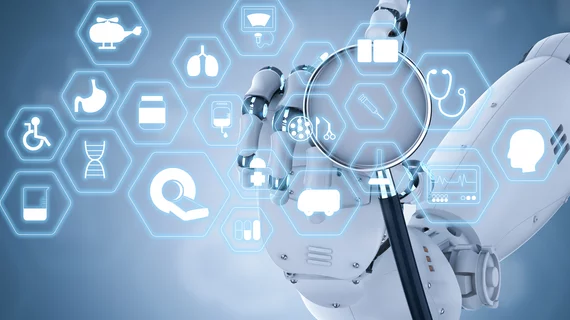The ‘disruptive dozen’: 12 AI technologies positioned to make the greatest impact in 2019
AI is poised to make a sizable impact on healthcare this year, but we’ll likely see the greatest dent in the areas of medical imaging, diagnostics and suicide risk prediction, according to data presented at the Partners HealthCare World Medical Innovation Forum in Boston.
A steering committee co-chaired by Partners HealthCare interim president and CEO Anne Klibanski, MD, and CCO Gregg Meyer, MD, held a meeting last November to cherry-pick this year’s “Disruptive Dozen,” a collection of the 12 technologies the committee thinks will have the greatest impact on AI in the next decade. In 2018, the No. 1 innovation was “AI at the bedside” and included tech like streamlined data management, automated patient monitoring and image interpretation.
This year, all nominated innovations had to have a strong potential for AI-related clinical impact, offer significant patient benefits in comparison to current practice, have a high probability of successful commercial deployment and be on the market by 2020.
From last to first, this is Partners HealthCare’s Disruptive Dozen for 2019:
12. Narrowing the gaps in mental health care
Researchers are contributing to mental health care with AI-based apps designed specifically for patients with mental illnesses and addictions. One phone app allows patients to participate in virtual integrated group therapy; another incorporates the principles of cognitive behavioral therapy and connects users with clinicians in real-time through a chat feature.
11. Voice-first technology
Smart speakers are commonplace now, but they have a unique role in the clinical space. Using speech recognition and natural language processing, tech companies are developing voice-first technology that can automate notes and provide guidance based on patient-physician conversations, freeing up more time for doctors to work one-on-one with their patients.
10. Identifying intimate partner violence
Researchers in Boston have been working on AI approaches to better identify patients who might have suffered from intimate partner violence (IPV) but are unable to communicate their situation. An analysis of imaging and EHR data from patients who were abused revealed patterns among IPV survivors, and those patterns are being generated into an AI-based system that will automatically alert physicians about probable IPV when a patient visits the hospital.
9. Revolutionizing acute stroke care
The 2017 finding that stroke patients can have an up to 24-hour window to receive clot-busting treatment—a big jump from previous research suggesting therapy has to be administered within 6 hours of infarction—opened new opportunities for AI development. Researchers are expanding a set of AI-powered tools that help review head CT scans to identify hemorrhages, localize their source and determine the volume of brain tissue affected by the stroke, making diagnosis a more painless process.
8. Reducing the burden of healthcare administration
With more than 25% of America’s healthcare expenses stemming from administrative costs, AI could make a big difference on the nonclinical side of medicine. The Partners committee said some of the most significant improvements in healthcare efficiency could be realized through the use of AI approaches that automate repetitive administrative tasks.
7. “FHIR” for health information exchange
AI is facilitating the process of exchanging healthcare information, namely with the Fast Healthcare Interoperability Resources (FHIR) standard, which allows patients to control and share their own data. Platforms like FHIR are transforming the industry, but they’re also making data more vulnerable, meaning “extra-stringent” protections will need to be put in place to protect patients’ information.
6. AI for eye health and disease
Last year, the FDA approved an AI-based system for detecting diabetic retinopathy, a condition that can result in permanent blindness. It was the first fully automated, AI-based diagnostic tool to reach the U.S. market and achieved 87.2% sensitivity and 90.7% specificity in testing, prompting other countries like the U.K. to launch similar projects in ophthalmology.
5. Real-time monitoring and analysis of brain health
Today physicians have to stand by a patient’s bedside to monitor the electrical activity of the brain, which is mapped with electroencephalograms, or EEGs. Through annotating EEG data from thousands of patients, researchers have developed new deep learning tools that make it possible to automate not only the analysis of EEGs but also other high-frequency waveforms, allowing for quicker detection of electric abnormalities.
4. Automated malaria detection
Global entities still grapple with how to manage malaria, which infected 219 million people in 2017 and remains difficult and slow to diagnose manually. A team in Washington developed a software program that helps automate malaria diagnoses with 90% accuracy and specificity, while other researchers have taken the idea further, loading diagnostic software onto smartphones for a more accessible, low-cost solution.
3. Streamlining diagnosis
AI isn’t only helping physicians read imaging scans more thoroughly and accurately—it’s also simplifying clinical workflows. At some institutions, algorithms are able to sort images by urgency, prioritizing exams that look abnormal. At others, it’s facilitating high-volume screening tests or sifting through thousands of data points to pull relevant notes for a diagnosis.
2. Better prediction of suicide risk
Clinical methods for flagging suicidal patients are notoriously inaccurate, but several teams are leveraging AI to develop risk prediction tools for suicidal behavior. Some of those researchers are using EHR data to build workable algorithms, while others are using machine learning and natural language processing to identify text messages and social media posts that predict self-harm.
1. Reimagining medical imaging
While ultrasound and X-rays have been used for decades and form the basis of a host of other imaging techniques like mammography, AI is improving the accuracy, sensitivity and accessibility of those technologies. Rather than a one-size-fits-all approach, mammograms are becoming more targeted tools for assessing breast cancer risk, equipped with the ability to read dense breast tissue more accurately with the added benefit of flagging patients for follow-up tests.

